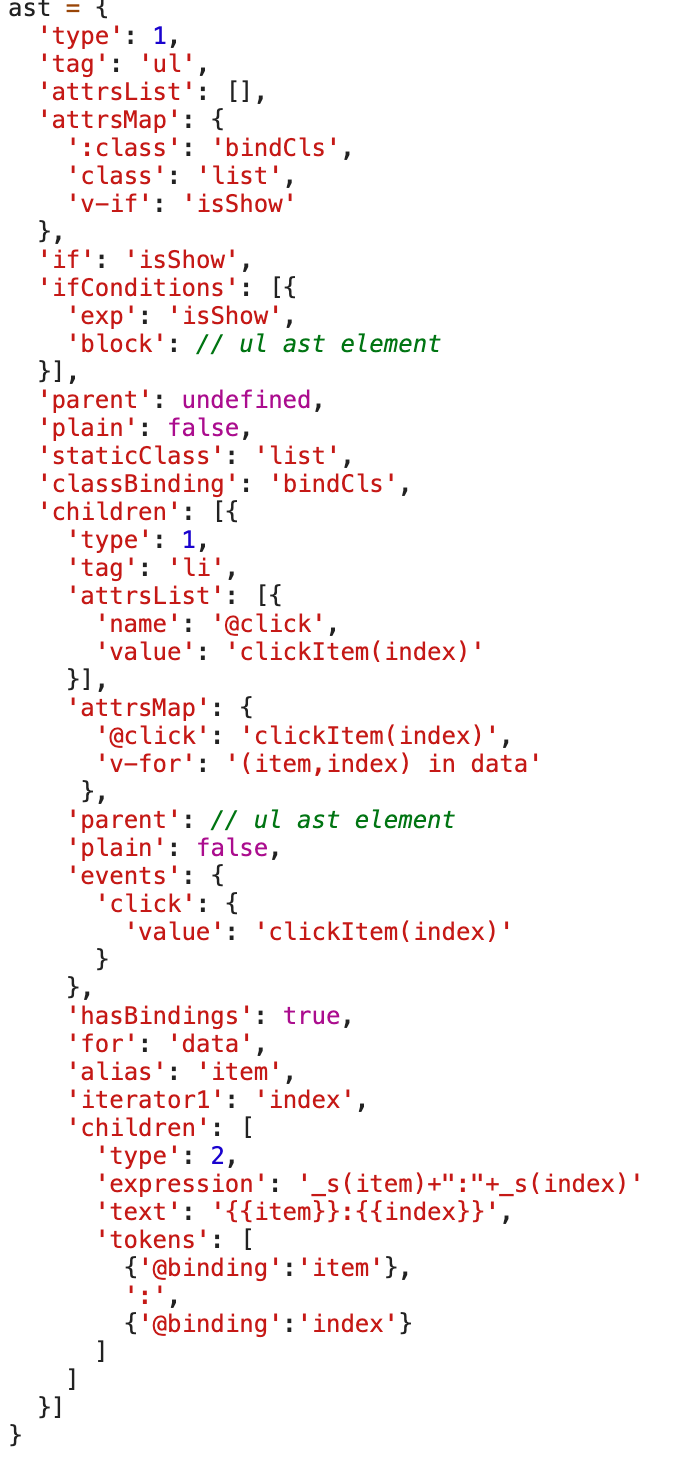# vue 原理解析之编译深入
# 编译入口
在之前分析数据驱动的时候,在 $mount 这个函数内调用 compileToFunctions 吗?下面我们再来看看这个方法
const { render, staticRenderFns } = compileToFunctions(template, {
shouldDecodeNewlines,
shouldDecodeNewlinesForHref,
delimiters: options.delimiters,
comments: options.comments
}, this)
options.render = render
options.staticRenderFns = staticRenderFns
2
3
4
5
6
7
8
compileToFunctions 方法就是把模板 template 编译生成 render 以及 staticRenderFns,它的定义在 src/platforms/web/compiler/index.js 中:
import { baseOptions } from './options'
import { createCompiler } from 'compiler/index'
const { compile, compileToFunctions } = createCompiler(baseOptions)
export { compile, compileToFunctions }
2
3
4
5
6
可以看到 compileToFunctions 方法实际上是 createCompiler 方法的返回值,该方法接收一个编译配置参数,接下来我们来看一下 createCompiler 方法的定义,在 src/compiler/index.js 中:
//createCompilerCreator 允许创建使用alternative 的编译器
//parser/optimizer/codegen, e.g the SSR optimizing compiler.
// 这里我们只是使用默认部分导出一个默认编译器
export const createCompiler = createCompilerCreator(function baseCompile (
template: string,
options: CompilerOptions
): CompiledResult {
const ast = parse(template.trim(), options)
if (options.optimize !== false) {
optimize(ast, options)
}
const code = generate(ast, options)
return {
ast,
render: code.render,
staticRenderFns: code.staticRenderFns
}
})
2
3
4
5
6
7
8
9
10
11
12
13
14
15
16
17
18
19
通过上述代码可以看出 createCompiler 就是 createCompilerCreator(传入一个 baseCompile 函数),接下来看看 createCompilerCreator 是一个什么呢:
export function createCompilerCreator (baseCompile: Function): Function {
return function createCompiler (baseOptions: CompilerOptions) {
function compile (
template: string,
options?: CompilerOptions
): CompiledResult {
const finalOptions = Object.create(baseOptions)
const errors = []
const tips = []
let warn = (msg, range, tip) => {
(tip ? tips : errors).push(msg)
}
if (options) {
if (process.env.NODE_ENV !== 'production' && options.outputSourceRange) {
// $flow-disable-line
const leadingSpaceLength = template.match(/^\s*/)[0].length
warn = (msg, range, tip) => {
const data: WarningMessage = { msg }
if (range) {
if (range.start != null) {
data.start = range.start + leadingSpaceLength
}
if (range.end != null) {
data.end = range.end + leadingSpaceLength
}
}
(tip ? tips : errors).push(data)
}
}
// merge custom modules
if (options.modules) {
finalOptions.modules =
(baseOptions.modules || []).concat(options.modules)
}
// merge custom directives
if (options.directives) {
finalOptions.directives = extend(
Object.create(baseOptions.directives || null),
options.directives
)
}
// copy other options
for (const key in options) {
if (key !== 'modules' && key !== 'directives') {
finalOptions[key] = options[key]
}
}
}
finalOptions.warn = warn
const compiled = baseCompile(template.trim(), finalOptions)
if (process.env.NODE_ENV !== 'production') {
detectErrors(compiled.ast, warn)
}
compiled.errors = errors
compiled.tips = tips
return compiled
}
return {
compile,
compileToFunctions: createCompileToFunctionFn(compile)
}
}
}
2
3
4
5
6
7
8
9
10
11
12
13
14
15
16
17
18
19
20
21
22
23
24
25
26
27
28
29
30
31
32
33
34
35
36
37
38
39
40
41
42
43
44
45
46
47
48
49
50
51
52
53
54
55
56
57
58
59
60
61
62
63
64
65
66
67
68
69
从上述代码中可以看出是一个柯里化函数
createCompilerCreator() =》createCompiler =》{ compile:function(){}, compileToFunctions: createCompileToFunctionFn(compile) }
最终返回的是一个对象,该对象属性 compileToFunctions 对应的就是 $mount 函数调用的 compileToFunctions 方法,它是调用 createCompileToFunctionFn 方法的返回值,我们接下来看一下 createCompileToFunctionFn 方法,它的定义在 src/compiler/to-function/js 中:
export function createCompileToFunctionFn (compile: Function): Function {
const cache = Object.create(null)
return function compileToFunctions (
template: string,
options?: CompilerOptions,
vm?: Component
): CompiledFunctionResult {
options = extend({}, options)
const warn = options.warn || baseWarn
delete options.warn
/* istanbul ignore if */
if (process.env.NODE_ENV !== 'production') {
// detect possible CSP restriction
try {
new Function('return 1')
} catch (e) {
if (e.toString().match(/unsafe-eval|CSP/)) {
warn(
'It seems you are using the standalone build of Vue.js in an ' +
'environment with Content Security Policy that prohibits unsafe-eval. ' +
'The template compiler cannot work in this environment. Consider ' +
'relaxing the policy to allow unsafe-eval or pre-compiling your ' +
'templates into render functions.'
)
}
}
}
// check cache
const key = options.delimiters
? String(options.delimiters) + template
: template
if (cache[key]) {
return cache[key]
}
// compile
const compiled = compile(template, options)
// check compilation errors/tips
if (process.env.NODE_ENV !== 'production') {
if (compiled.errors && compiled.errors.length) {
if (options.outputSourceRange) {
compiled.errors.forEach(e => {
warn(
`Error compiling template:\n\n${e.msg}\n\n` +
generateCodeFrame(template, e.start, e.end),
vm
)
})
} else {
warn(
`Error compiling template:\n\n${template}\n\n` +
compiled.errors.map(e => `- ${e}`).join('\n') + '\n',
vm
)
}
}
if (compiled.tips && compiled.tips.length) {
if (options.outputSourceRange) {
compiled.tips.forEach(e => tip(e.msg, vm))
} else {
compiled.tips.forEach(msg => tip(msg, vm))
}
}
}
// turn code into functions
const res = {}
const fnGenErrors = []
res.render = createFunction(compiled.render, fnGenErrors)
res.staticRenderFns = compiled.staticRenderFns.map(code => {
return createFunction(code, fnGenErrors)
})
// check function generation errors.
// this should only happen if there is a bug in the compiler itself.
// mostly for codegen development use
/* istanbul ignore if */
if (process.env.NODE_ENV !== 'production') {
if ((!compiled.errors || !compiled.errors.length) && fnGenErrors.length) {
warn(
`Failed to generate render function:\n\n` +
fnGenErrors.map(({ err, code }) => `${err.toString()} in\n\n${code}\n`).join('\n'),
vm
)
}
}
return (cache[key] = res)
}
}
2
3
4
5
6
7
8
9
10
11
12
13
14
15
16
17
18
19
20
21
22
23
24
25
26
27
28
29
30
31
32
33
34
35
36
37
38
39
40
41
42
43
44
45
46
47
48
49
50
51
52
53
54
55
56
57
58
59
60
61
62
63
64
65
66
67
68
69
70
71
72
73
74
75
76
77
78
79
80
81
82
83
84
85
86
87
88
89
90
91
92
93
94
至此总算找到了 compileToFunctions 的最终定义,它接收 3 个参数、编译模板 template,编译配置 options 和 Vue 实例 vm。核心的编译过程就一行代码:
const compiled = compile(template, options)
compile 到底是什么呢,来屡屡逻辑
刚开始 createCompilerCreator(传入 baseCompile 函数)=》到 createCompilerCreator 返回对象 { compile:function(){}, compileToFunctions: createCompileToFunctionFn(compile) }====》找到 compile ====》const compiled = baseCompile(template.trim(), finalOptions)
compile 函数执行的逻辑是先处理配置参数,真正执行编译过程就一行代码:
const compiled = baseCompile(template, finalOptions)
baseCompile 在执行 createCompilerCreator 方法时作为参数传入,如下:
export const createCompiler = createCompilerCreator(function baseCompile (
template: string,
options: CompilerOptions
): CompiledResult {
const ast = parse(template.trim(), options)
optimize(ast, options)
const code = generate(ast, options)
return {
ast,
render: code.render,
staticRenderFns: code.staticRenderFns
}
})
2
3
4
5
6
7
8
9
10
11
12
13
所以编译的入口我们终于找到了,它主要就是执行了如下几个逻辑:
const ast = parse(template.trim(), options) ===>解析模板字符串生成 AST
optimize(ast, options). =====>优化语法树
const code = generate(ast, options) =====》生成代码
# parse
parse 是对模版解析,生成 ast,它是抽象语法树(是对源代码的抽象语法结构的树状的表现形式)
通过上述还是有点模糊😢,来个例子直观一些😄:
<ul :class="bindCls" class="list" v-if="isShow">
<li v-for="(item,index) in data" @click="clickItem(index)">{{item}}:{{index}}</li>
</ul>
2
3
经过 parse 过程后,生成的 AST 如下:
